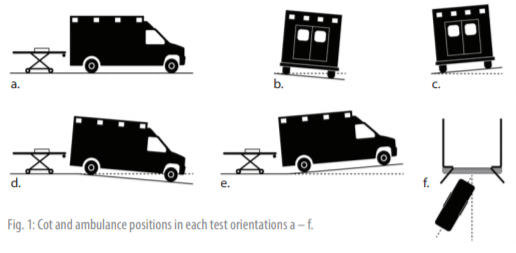Technical Study
Powered cots have been shown to reduce spinal compression forces in emergency service professionals by as much as 50%1. However, the EMS work environment often results in cot loading and unloading scenarios plagued by off-axis, uneven approach conditions. This, coupled with patient weight, can make the job of the EMS professional very difficult even with a powered cot, and it can result in poor ergonomics and high lumbar and joint stresses.1 At some angles, the cot may not be able to load into the fastener at all. The purpose of this study was to evaluate the angles at which two commercially available emergency cots would no longer load into the fastener.
Methods
Two emergency cots were loaded and unloaded into a simulated ambulance in this study. The FERNO POWER X1 Ambulance Cot (Wilmington, OH) and Stryker Power-PRO™ XT (Portage, MI) cot were kept on the horizontal, and one corner of a simulated ambulance was positioned at a maximum height per the ambulance floor height standard.2 Six ambulance floor orientations were tested (Figure 1). When viewed from the rear as if loading or unloading a cot, the ambulance floor was adjusted either a) parallel to the horizontal, b) at negative (-) degree increments when viewed from left to right, or c) at positive (+) degree increments from left to right. When viewed from the side, the floor was also adjusted either d) at negative (-) degree increments when viewed from rear to front, or e) at positive (+) degree increments from rear to front. When both the cot and the floor were placed on the horizontal, multiple cot approach angles were also tested (Figure 1f). The PRO F1™ Universal Cot Fastener (FERNO) and Stryker Power-LOAD® fastener were mounted to the ambulance floor per the manufacturer’s installation instructions. Each cot was loaded into the respective fastener with 1) no simulated patient and 2) a simulated patient weight of 250 lbf (1112 N). Each cot was also tested with a simulated patient weight of 700 lbf (3114 N) in scenario (f).

Results
Both cots unloaded and loaded when the cot and fastener were parallel to the horizontal (orientation a) at both simulated patient weights. In the (b) orientation, the maximum angle the Power-PRO XT could be unloaded or loaded was -6.0 degrees at both simulated patient weights. The POWER X1 unloaded and loaded up to -12.0 degrees without weight and up to -10.7 degrees with weight, representing up to a 100% increase in flexibility. In the (c) orientation, the maximum angle at which the Power-PRO XT and POWER X1 cots could be unloaded or loaded was 3.0 degrees at both simulated patient weights. It should be noted that the (c) orientation resulted in the right side of the simulated ambulance floor being above the maximum height standard (see Figure 1c).2 In the (d) orientation, the maximum angle the Power-PRO XT could be unloaded or loaded was -3.0 degrees at both simulated patient weights. The POWER X1 unloaded and loaded up to -7.0 degrees at both simulated weights, representing a 133% increase in flexibility. In the (e) orientation, the maximum angle the Power-PRO XT could be unloaded or loaded was 3.0 degrees at both simulated patient weights. The POWER X1 unloaded and loaded up to 12.0 degrees at both simulated weights, representing a 300% increase in flexibility. The maximum approach angle capability of the Power-PRO XT cot and Power-LOAD fastener was found to be load dependent (p < 0.05) and ranged from 16 degrees at full capacity to 20 degrees with an unloaded cot. In this scenario, the Stryker Power-PRO XT would not load into the Power-LOAD without lift assistance. The POWER X1 and PRO F1 were capable of 55 degrees of off-axis approach angle regardless of the load on the patient surface (Figure 2).
Conclusions
If an emergency cot and ambulance floor are at different angles with respect to one another, such as is often the case when parked on a hill, driveway, or curb, or when the EMS professional approaches the back of the ambulance at a slightly off-axis angle, then the unloading and loading dynamics of the cot are changed. In some cases, the cot will not load at all even with assistance from the EMS professional. In this study, an increase in flexibility during loading and unloading was observed with the POWER X1 Ambulance Cot and PRO F1 Universal Cot Fastener as compared to the Stryker PowerPRO XT and Power-LOAD fastener combination. There was also a nearly three-fold increase in the off-axis loading capability with the POWER X1 versus the Power-PRO XT cot. At offset approach angles, cot choice can leave the EMS professional with an increase in load to bear. A cot with greater flexibility with regard to off-axis mismatch of the cot/fastener interface proved beneficial to the EMS professional in this study.
Key Definitions
“N”=“Newton”— the standard unit of force in the International System of Units.LBF— The pound-force (symbol: lbf, or lbf ) is a unit of force.
For purposes of this white paper, LBF represents “simulated patient weight” and “N” is used as a unit of measurement during stability testing.
(1) Fredericks et. al. Evaluation of Medical Cot Design Considering the Biomechanical Impact on Emergency Response Personnel, 2013. (2) Federal Specification for the Star-of-Life Ambulance, KKK-A-1822.

